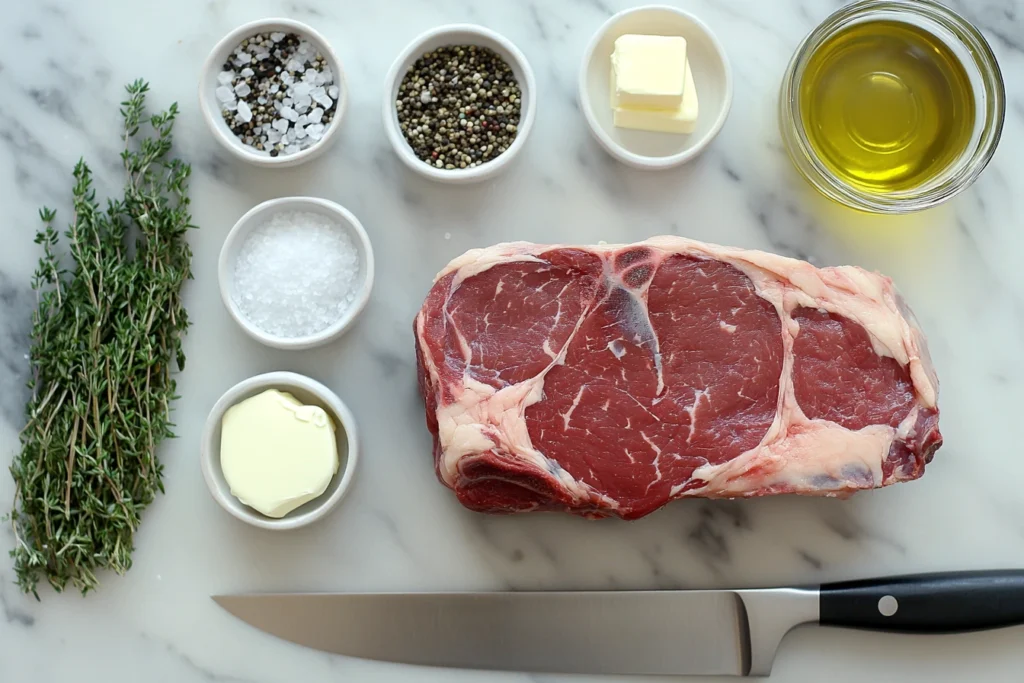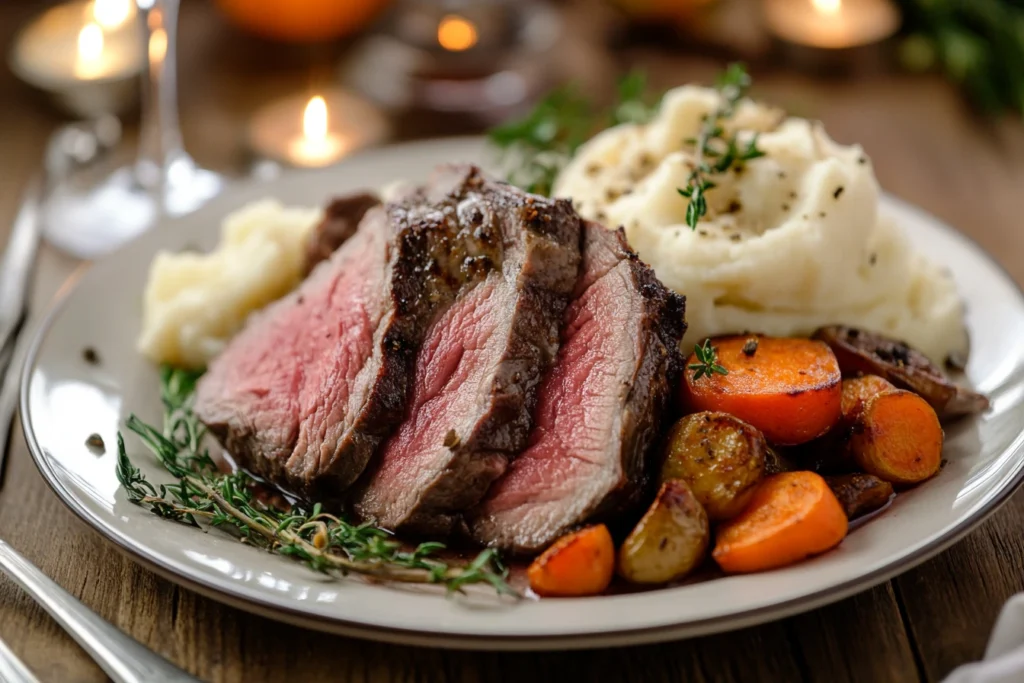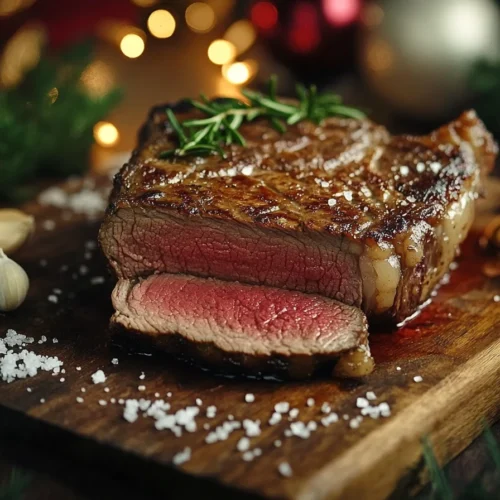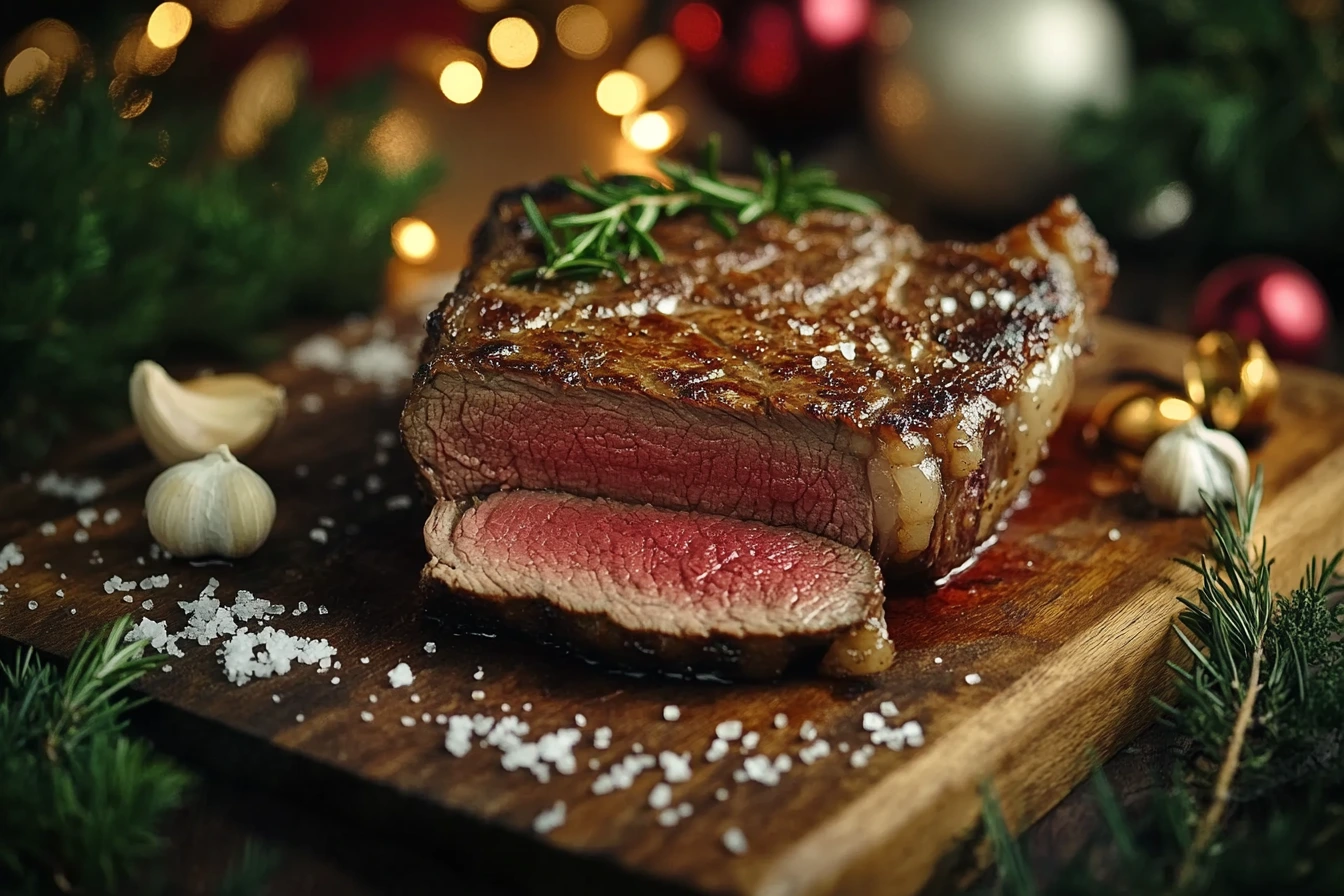When it comes to show-stopping meals that wow your guests, few dishes can compete with a perfectly cooked ribeye roast. With its rich marbling, tender texture, and bold, beefy flavor, this cut of meat is a guaranteed crowd-pleaser whether you’re hosting a holiday feast, Sunday dinner, or just craving something truly indulgent.
But let’s be honest cooking a ribeye roast can feel intimidating. The fear of overcooking (or under-seasoning) this premium cut can make even experienced home cooks hesitate. The good news? Making a juicy, restaurant-quality ribeye roast at home is way easier than you think. All it takes is the right technique, quality ingredients, and a little patience.
In this comprehensive guide, we’ll cover everything you need to know to master the ultimate ribeye roast recipe. You’ll learn about selecting the perfect cut, prepping and seasoning like a pro, and cooking your roast to juicy perfection. Plus, we’ll dive into expert tips, flavorful variations, and answer common questions like “Is ribeye roast the same as prime rib?” and “What’s the ideal cooking temperature?”
Table of Contents
Introduction to Ribeye Roast
Why a Ribeye Roast Is the Perfect Centerpiece
There’s a reason why a ribeye roast often takes center stage at special occasions it’s pure decadence on a platter. This beautifully marbled cut of beef comes from the rib section of the cow, making it naturally tender, juicy, and packed with rich, savory flavor. When cooked correctly, every bite offers a melt-in-your-mouth experience that feels both indulgent and comforting.
One of the best things about making a ribeye roast recipe is that it doesn’t require fancy techniques. The roast itself does most of the heavy lifting, thanks to its marbling and natural juiciness. A simple seasoning blend and proper roasting technique are all you need to let the meat’s bold flavors shine through.
Plus, it’s a versatile centerpiece that pairs well with just about anything from buttery mashed potatoes to garlicky green beans or even a crusty slice of artisan bread. Whether you’re preparing a festive holiday meal or a luxurious weekend dinner, a ribeye roast will make your table feel like a five-star restaurant.
What You’ll Learn from This Recipe Guide
In this step-by-step guide, we’ll cover everything you need to know to make the perfect ribeye roast recipe from scratch. Here’s what you can expect:
- 🥩 Understanding Ribeye Cuts: Learn what makes ribeye unique and how it compares to other popular cuts like prime rib.
- 🍳 Prepping and Seasoning Techniques: Discover how to prepare your roast for cooking and create a flavorful crust.
- 🔥 Cooking Instructions: A foolproof method for getting that tender, juicy interior with a perfectly crispy exterior.
- 🧑🍳 Expert Tips: Pro tricks to avoid common mistakes and get the best results every time.
- 🍽️ Serving Suggestions: The best sides to complement your ribeye roast.
By the time you’re done reading, you’ll have all the tools and confidence you need to create a mouthwatering ribeye roast that’ll have everyone asking for seconds.
Ready to dive in? Let’s start by understanding what makes a ribeye roast so special. 🥩🔥
Understanding Ribeye Roast Cuts
What Is a Ribeye Roast?
A ribeye roast is a luxurious cut of beef taken from the rib section of the cow, specifically from ribs six through twelve. Known for its rich marbling and tender texture, this cut offers bold, beefy flavors that are hard to match. The marbling those creamy veins of fat running through the meat melts as it cooks, making every bite juicy, tender, and packed with flavor.
This cut is often referred to as the « king of roasts » because it strikes the perfect balance between tenderness and robust, meaty goodness. It’s versatile too you can roast it whole for a show-stopping centerpiece or cut it into steaks (better known as ribeye steaks).
The ribeye roast recipe is particularly popular for holiday feasts and special gatherings. Why? Because it looks impressive on the table and delivers flavors that leave guests asking for seconds.
Is a Ribeye Roast the Same as Prime Rib?
Many people confuse ribeye roast with prime rib, but while they share similarities, they’re not exactly the same. Both cuts come from the same section of the cow, but the key differences lie in preparation and presentation.
- Prime Rib is usually cooked with the bone in, and it often includes a thick cap of fat that renders down during cooking, adding flavor and tenderness. It’s typically slow-roasted and served medium rare with a rich au jus.
- Ribeye Roast, on the other hand, can be cooked bone-in or boneless. It’s slightly leaner than prime rib but still incredibly juicy and flavorful. It’s often roasted to develop a crispy outer crust while keeping the inside tender and moist.
So, while all prime rib is technically a ribeye roast, not all ribeye roasts are prime rib. If you’re aiming for a more manageable roast that’s easier to slice and cook, the ribeye roast recipe is your best bet for a foolproof, flavorful result.
Key Ingredients for the Best Ribeye Roast Recipe
Essential Ingredients You’ll Need
Making the perfect ribeye roast recipe doesn’t require a long list of fancy ingredients. In fact, simplicity is key letting the natural flavors of the meat shine through. Here’s everything you need to get started:
- Ribeye Roast (boneless or bone-in): A high-quality, well-marbled roast is essential for juicy, tender results. Aim for about 4–6 pounds for a crowd.
- Kosher Salt: Helps draw out the meat’s natural flavors while creating a beautiful crust.
- Freshly Ground Black Pepper: Adds a bold, slightly spicy kick.
- Unsalted Butter: Adds richness and helps the seasoning stick to the meat.
- Garlic Cloves (minced): Infuses the roast with a warm, savory aroma.
- Fresh Herbs: Rosemary, thyme, and sage are perfect for complementing the roast’s rich flavor.
- Olive Oil: Helps the roast brown evenly and locks in moisture.
Choosing Quality Ingredients for Maximum Flavor
The secret to an unforgettable ribeye roast recipe isn’t complicated it’s all about quality ingredients. Here’s what you should look for:
- Well-Marbled Beef: Choose USDA Prime or Choice cuts for the best flavor and tenderness. More marbling means more juicy goodness when cooked.
- Fresh Herbs Over Dried: Fresh rosemary, thyme, and sage bring a fragrant, earthy touch that dried herbs just can’t match.
- High-Quality Butter: European-style butter, with its higher fat content, offers a creamier, richer base for your seasoning blend.
- Coarse Salt: Kosher or sea salt helps form that irresistible crust without making the meat overly salty.
If you’re looking for more inspiration with hearty recipes, check out this ground beef crockpot recipe collection. It’s packed with comforting meals perfect for any occasion.
How to Prepare and Season a Ribeye Roast

Prepping the Ribeye for Cooking
Before you even think about turning on the oven, proper preparation is key to ensuring your ribeye roast recipe turns out juicy, flavorful, and tender. Here’s how to set yourself up for success:
- Bring the Roast to Room Temperature: Take the ribeye roast out of the fridge at least 1 hour before cooking. Allowing it to reach room temperature ensures even cooking and helps avoid an overcooked outer layer.
- Trim Excess Fat: While the fat is essential for flavor and moisture, trimming off large chunks of excess fat helps the roast cook more evenly. Leave a thin layer this will melt during cooking, adding juicy richness.
- Pat It Dry: Moisture on the surface can hinder a good sear. Use paper towels to thoroughly pat the roast dry, ensuring a crispier crust later on.
- Score the Fat Cap: Lightly score any remaining fat by making shallow cuts in a crisscross pattern. This helps the fat render evenly and infuses the meat with extra flavor as it roasts.
- Tie the Roast (Optional): If your roast isn’t uniformly shaped, use kitchen twine to tie it into a more even cylinder. This promotes even cooking and helps maintain a juicy interior.
The Perfect Seasoning Blend for Ribeye Roast Recipe
The best ribeye roast recipe doesn’t need an overcomplicated seasoning. The goal is to complement the natural, beefy flavor of the meat not cover it up. Here’s how to create a simple, flavor-packed seasoning blend:
Ingredients for Seasoning:
- 2 tablespoons kosher salt
- 1 tablespoon freshly ground black pepper
- 4 cloves garlic, minced
- 1 tablespoon fresh rosemary, finely chopped
- 1 tablespoon fresh thyme, finely chopped
- ½ cup unsalted butter, softened
- 2 tablespoons olive oil
How to Season Your Roast:
- Make a Garlic Herb Butter: In a small bowl, mix the softened butter, garlic, rosemary, thyme, salt, and pepper until well combined.
- Rub Generously: Coat the entire surface of the roast with olive oil. Then, massage the garlic herb butter into the meat, making sure to get into every nook and cranny especially around the scored fat.
- Let It Sit: After seasoning, let the roast rest at room temperature for another 15–20 minutes. This allows the flavors to infuse into the meat and creates a delicious crust when it hits the oven.
This seasoning method guarantees a perfectly seasoned, flavor-packed crust while keeping the inside tender and juicy.
Step-by-Step Ribeye Roast Recipe Cooking Instructions
What Temperature Should a Ribeye Roast Be Cooked At?
Getting the temperature right is crucial for a perfectly cooked ribeye roast recipe. You want to strike the balance between a crispy, flavorful crust on the outside and a tender, juicy inside.
Oven Temperature Guide:
- Preheat your oven to 450°F (232°C). A high initial temperature helps create a flavorful crust.
- After 15 minutes, reduce the heat to 325°F (163°C) and continue roasting until the desired internal temperature is reached.
Internal Temperature Guide for Desired Doneness:
- Rare: 120°F – 125°F (49°C – 52°C)
- Medium-rare: 130°F – 135°F (54°C – 57°C)
- Medium: 140°F – 145°F (60°C – 63°C)
- Medium-well: 150°F – 155°F (65°C – 68°C)
Using a meat thermometer is the best way to ensure precision and prevent overcooking.
Do You Sear a Ribeye Roast First or Last?
Here’s a common question for first-time roast makers: Do you sear a ribeye roast before or after roasting? The answer depends on the texture you’re aiming for.
- Searing Before Roasting: Starting with a high-heat sear locks in juices and creates a flavorful crust early on. It’s the traditional method and works well for achieving that signature golden-brown crust.
- Searing After Roasting (Reverse Sear): Some chefs prefer to roast the meat at a lower temperature first and then finish it off with a high-heat sear. This method can result in a more evenly cooked roast with an extra-crispy exterior.
For this ribeye roast recipe, I recommend searing before roasting for a guaranteed flavorful crust. It’s simple, effective, and yields that classic, mouthwatering outer layer.
How to Rest and Carve the Roast Properly
Resting the meat is just as important as cooking it. Without it, all those flavorful juices will run out when you cut into the roast.
- Rest the Roast: After removing it from the oven, cover the roast loosely with foil and let it rest for at least 20 minutes. This allows the juices to redistribute throughout the meat.
- Carve Like a Pro: Use a sharp carving knife and slice against the grain for tender, easy-to-chew pieces. Aim for slices about ¼-inch thick for the perfect bite.
- Serve and Enjoy: Serve with your favorite sides, like garlic mashed potatoes or roasted vegetables, for a meal that’s truly unforgettable.
For more hearty dinner ideas that pair beautifully with this roast, check out this cozy broccoli cauliflower soup recipe it’s the perfect warm, comforting side dish to accompany your beautifully cooked ribeye roast.
Delicious Ribeye Roast Recipe Variations
Garlic Herb Crusted Ribeye Roast
If you’re craving a more aromatic and flavorful twist, this garlic herb crusted ribeye roast recipe is a must-try. The rich, savory blend of fresh herbs and garlic brings out the natural juiciness of the ribeye while adding an irresistible, crispy crust.
How to Make It:
- Create the Crust: In a bowl, mix together 1 cup of panko breadcrumbs, 2 tablespoons minced garlic, ¼ cup chopped fresh parsley, 1 tablespoon rosemary, and ½ cup melted butter.
- Season Generously: Pat the seasoning blend over the entire roast, pressing it firmly into the meat to ensure it sticks.
- Roast as Usual: Follow the same cooking instructions from the main ribeye roast recipe, allowing the crust to form a golden, crunchy layer.
The result? A beautifully fragrant roast with a crisp, herbaceous crust that elevates every bite.
Spicy Peppercorn Ribeye Roast Recipe
For those who like a little heat, a spicy peppercorn ribeye roast adds bold, punchy flavors to the classic recipe. The cracked peppercorns create a smoky, spicy crust that perfectly complements the roast’s rich marbling.
How to Make It:
- Create the Spice Blend: Combine 3 tablespoons of coarsely crushed black peppercorns, 1 teaspoon of cayenne pepper, 2 tablespoons kosher salt, and 1 tablespoon paprika.
- Season the Roast: Coat the ribeye roast in olive oil, then rub the spice mixture generously over the entire surface.
- Cook and Rest: Follow the same roasting instructions, allowing the peppercorn crust to form a bold, flavorful seal.
This fiery take on the ribeye roast recipe is perfect for spice lovers and pairs beautifully with creamy mashed potatoes or a cool cucumber salad.
Smoked Ribeye Roast Recipe
If you’re a fan of smoky flavors, this variation takes your ribeye roast recipe to the next level by adding rich, deep smokiness using a grill or smoker. It’s a perfect choice for outdoor gatherings or BBQ enthusiasts.
How to Make It:
- Preheat Your Smoker: Set your smoker to 225°F (107°C) and use wood chips like hickory or oak for a bold smoky flavor.
- Season as Usual: Use the classic garlic, herb, and butter rub from the original recipe.
- Smoke the Roast: Place the ribeye roast directly on the smoker and cook until the internal temperature reaches 130°F (54°C) for medium-rare. This usually takes about 3–4 hours.
- Sear for Finish: Once smoked, sear the roast over high heat for 2 minutes per side to lock in that smoky crust.
This variation gives your roast an irresistible smoky aroma and flavor that’s ideal for special occasions or summer BBQs.
Expert Tips for a Perfect Ribeye Roast Recipe Every Time
Using a Meat Thermometer for Accurate Cooking
One of the most crucial tools for any ribeye roast recipe is a reliable meat thermometer. It ensures your roast is cooked to perfection whether you prefer it rare, medium, or well-done.
Why It’s Essential:
- Prevents overcooking and dryness.
- Ensures the roast is safe to eat by reaching the correct internal temperature.
- Helps you achieve consistent, restaurant-quality results every time.
Pro Tip: Insert the thermometer into the thickest part of the roast, avoiding bone or fat pockets for the most accurate reading.
Common Mistakes to Avoid
Even though cooking a ribeye roast is straightforward, there are a few common mistakes that can ruin your roast. Avoid these pitfalls to ensure a juicy, flavorful result every time:
- Skipping the Rest Period: Cutting into the roast immediately after cooking causes all those delicious juices to spill out. Always let the meat rest for at least 20 minutes.
- Underseasoning the Meat: A quality cut deserves a robust seasoning blend. Don’t be afraid to use plenty of salt, pepper, herbs, and garlic to enhance the flavor.
- Overcooking the Roast: Ribeye roast is best enjoyed medium-rare to medium. Anything beyond that can dry out the meat and diminish the flavor.
- Not Letting the Meat Reach Room Temperature: If the roast is too cold when you start cooking, it may cook unevenly, leaving you with an overcooked outside and undercooked center.
By following these expert tips, your ribeye roast recipe will turn out perfectly every single time juicy, flavorful, and sure to impress anyone lucky enough to grab a slice.
Best Side Dishes to Serve with Ribeye Roast Recipe

Classic Pairings for a Ribeye Roast Dinner
A rich, flavorful ribeye roast recipe deserves side dishes that complement its bold, juicy taste. The best pairings are those that highlight the roast’s savory depth while providing balance with lighter, comforting flavors.
Here are a few timeless classics to round out your ribeye roast feast:
- Garlic Mashed Potatoes: Creamy and buttery, these potatoes are the perfect companion to soak up those delicious meat juices. Add a touch of roasted garlic for extra depth.
- Sautéed Mushrooms: Earthy and tender, mushrooms cooked in butter, garlic, and a splash of red wine complement the meaty richness of the ribeye.
- Roasted Vegetables: A colorful mix of carrots, Brussels sprouts, and parsnips seasoned with olive oil, salt, pepper, and thyme adds a sweet, caramelized crunch.
- Yorkshire Pudding: A classic British side traditionally served with roasts, this light, airy pastry soaks up gravy beautifully and adds a delightful texture to your meal.
These sides are simple but elegant perfect for holiday meals, Sunday dinners, or any special occasion.
Creative Side Dishes for Special Occasions
If you’re aiming to elevate your ribeye roast recipe for a more festive or creative occasion, try these unique twists:
- Sweet Potato Casserole: Creamy sweet potatoes topped with brown sugar, cinnamon, and pecans bring a sweet-and-savory contrast that pairs beautifully with the richness of the roast.
- Crispy Parmesan Brussels Sprouts: Tossed with parmesan cheese and roasted until crispy, these sprouts add both flavor and crunch.
- Wild Rice Pilaf: Infused with herbs, toasted almonds, and dried cranberries, this hearty, slightly nutty dish adds texture and depth to your roast dinner.
- Cranberry and Goat Cheese Salad: A fresh, zesty salad made with arugula, cranberries, goat cheese, and a balsamic glaze offers a bright contrast to the rich meat.
Pairing your roast with these creative sides will transform your meal into a memorable dining experience perfect for impressing your guests at your next gathering.
Frequently Asked Questions (FAQ)
Is a Ribeye Roast the Same Thing as Prime Rib?
This is one of the most common questions when it comes to preparing a ribeye roast recipe. While they’re similar cuts from the same section of the cow, there are key differences:
- Prime Rib: Typically cooked bone-in, prime rib is known for its fatty, tender texture. It’s often slow-roasted and served with au jus and horseradish sauce for added richness.
- Ribeye Roast: This cut can be cooked bone-in or boneless, but it’s usually leaner than prime rib while still maintaining a good amount of marbling. It’s often seasoned simply and roasted to create a flavorful crust.
In short, all prime ribs are ribeye roasts, but not all ribeye roasts are considered prime ribs. The difference mainly lies in preparation and presentation.
What Temperature Should a Ribeye Roast Be Cooked At?
For the best results, start by preheating your oven to 450°F (232°C). After searing for about 15 minutes, reduce the heat to 325°F (163°C) and roast until you reach your desired internal temperature.
Here’s a quick guide for doneness based on internal temperature:
- Rare: 120°F – 125°F (49°C – 52°C)
- Medium-Rare: 130°F – 135°F (54°C – 57°C)
- Medium: 140°F – 145°F (60°C – 63°C)
- Medium-Well: 150°F – 155°F (65°C – 68°C)
Always use a meat thermometer for accuracy it’s the secret to getting that perfect, juicy roast every time.
Is Ribeye Good for Roasting?
Absolutely! A ribeye roast recipe is an excellent choice for roasting thanks to its generous marbling, which keeps the meat juicy and tender during the cooking process. The fat melts as the roast cooks, infusing the meat with rich, buttery flavor.
Whether it’s served rare or medium-well, a ribeye roast holds its shape beautifully while delivering melt-in-your-mouth tenderness with every bite.
Do You Sear a Ribeye Roast First or Last?
You can sear your ribeye roast either before or after roasting, depending on the result you want:
- Sear First: This traditional method locks in juices and creates a crispy, flavorful crust before roasting.
- Reverse Sear: For a more evenly cooked roast, slow-cook it first, then sear it afterward for a perfect, caramelized crust.

Ribeye Roast Recipe: Simple, Juicy, And Packed With Unforgettable Flavor
Equipment
- Roasting Pan
- Meat Thermometer
Ingredients
Ribeye Roast
- 5 lb ribeye roast bone-in or boneless
- 2 tbsp olive oil
- 1 tbsp kosher salt
- 1 tbsp black pepper freshly ground
- 4 cloves garlic minced
- 2 tbsp fresh rosemary chopped
Instructions
- Preheat your oven to 450°F (230°C).
- Rub the ribeye roast with olive oil, salt, pepper, minced garlic, and rosemary.
- Place the roast in a roasting pan, fat side up.
- Roast for 15 minutes at 450°F, then reduce the oven temperature to 325°F (163°C) and continue roasting for about 2 hours or until the internal temperature reaches 135°F (57°C) for medium-rare.
- Remove from oven and let it rest for 15 minutes before slicing.

